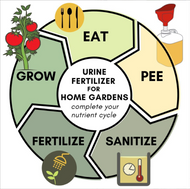The revolution will be fertilized. Using urine to grow food and ornamentals.
Posted by Krista Eickmann on 24th Apr 2023
As spring is kicking in to gear (about two weeks early ahem climate change) a lot of folks are thinking about gardening. Maybe it's just a few herbs and flowers, maybe some containers with veggies, or maybe a sizeable garden.
Growing food for yourself and your loved ones is a celebration of our existence as living creatures on this precious planet. It's something that can soothe our minds and souls, get us outside, and provide the freshest most delicious food out there.
Just as we need to eat, so do our plants. Feeding plants and understanding soil chemistry can get extremely complex.
The cool thing is that we make our own fertilizer every single day when we pee. Before people started synthesizing and isolating the nutrients that plants need - aka chemical fertilizer - urine was a hot commodity.
The nutrients found in chemical fertilizers are also found in our urine! Nitrogen, phosphorus, and potassium are the big three. Urine has them all, as well as calcium, magnesium, sulfur, and many of the important micro nutrients plants need.
The reality of chemical fertilizers is that they are much more highly concentrated than natural forms of plant food. Their application often results in run off that has too much nitrogen and phosphorus in it. If this water enters our rivers, streams, and lakes, it causes harmful algae blooms which end up killing fish and other aquatic life and making the water unsafe for people to swim or recreate in.
Many communities have invested big bucks into sewage treatment plants that will take the fresh water we polluted by peeing into it and clean it up so it doesn't pollute waterways.
Urine belongs on the soil, feeding plants that will in turn feed us. When it is saved and applied to growing plants properly, they use it and keep it from harming the bodies of water we love so much.
So, how to use urine as fertilizer safely? If you have trees or bushes you can actually just pee directly onto the ground about 1 foot away from the trunk of the plant. The pStyle makes this really easy for folks who can't already stand and pee while clothed.
You won't really get optimal fertilization using this method, although it is simple and convenient. It's better to collect urine and be able to apply a good amount of it at the correct time. There are as many ways to do this as there are containers in the world, however, The Rich Earth Institute has come up with a pretty nice system you can check out in their handy guide. Again, the pStyle makes peeing into a collection device much easier!
Put some vinegar into your container when you start collecting to keep the smell down. It's chemistry but I can't explain it! When used in conjunction with a ping pong ball in the collection device there is little to no smell.
Urine has exceedingly small amounts of bacteria in it, so it's much safer to deal with than poop.
When it comes to sterilizing urine, it's not necessary if you will just be fertilizing ornamental plants or will not be sharing urine fertilized food with folks from outside your household. If you plan to share your produce you can store the urine for six months in it's container and then it's ready to use. It's also advised to stop fertilizing with urine about a month before you plan to eat your crops.
This is actually perfect though because the ideal time to fertilize crops with urine is during their growing stage. Once they start to flower and fruit it's best to stop fertilizing anyways. A few other tips are to apply urine a few inches away from the base of your plants when soil is wet, or before a rain, so the nutrients will be delivered to the plant roots for use, instead of off gassing into the air.
Urine My Garden is a PDF put together by the Rich Earth Institute that sums up everything you need to know to get started in three pages. It can feel daunting or mysterious, but once you start experimenting you will find it's pretty easy.


